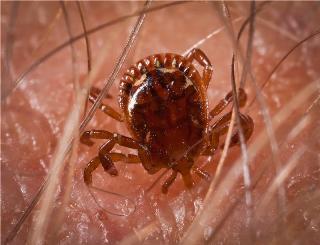Sep 1 2015
The common tick is a parasite whose bite damages the flesh and skin of cattle, as well as affects the quality of their milk, plus it can transmit infections to humans.

However, having a health check of this vector is not an easy task, because some of the current strains are highly resistant to insecticides offered in the international market.
Faced with this problem, a scientific group at the National University of Mexico (UNAM) designed a new external antiparasitic in the form of nanoparticles to attack the tick, which the laboratory has shown to be less toxic than the currently marketed, it does not harm the environment or the people who apply it.
The innovative product has a national patent owned by UNAM and through the Mexican company QSAR Analytics it seeks to partner with other companies for industrial manufacturing and venture on the veterinary pharmaceutical market.
Doctors in chemistry Enrique Angeles Anguiano and Fernando Alba Hurtado, who head the scientific group at the UNAM, explained that the components of the antiparasitic are not absorbed by the gastrointestinal tract of cattle, so they do not circulate in the bloodstream and do not affect quality of their meat nor their milk, which does happen with the products currently used.
They also explained that some antiparasitics are of such toxicity that when excreted by the cattle they prevent the growth of grass on the site, while killing beetles and bees (among other insects), affecting the biological chain.
The tick represents a health problem as it carries different diseases, but it also represents economical loses, and has for many years, which has led to the interest of many scientific researchers worldwide.
"Today in Mexico we have several tick strains that are resistant to almost all compounds on the market, so we designed a series of antiparasitic nano-products, which have drawn the attention of international laboratories, because it has an efficiency of 99.5 percent, ie practically disappears the tick in any of its four stages of life: nymph, pupa, adult and egg" details Angeles Anguiano.
To defeat the high resistance that ticks have to several chemicals, international laboratories currently make cocktails that include various compounds, but this results in high costs and is highly toxic to the environment, cattle and the people who manipulate the substance.
The head of the scientific team explains that the synthesis of the product consists of a single step or "bucket chemistry", as its preparation is simple. "The methodology implemented in the laboratory allows us to increase performance, plus we have very stable pure products, of low toxicity.
"We can also say that this is a specific antiparasitic for the ticks because if the compound is applied in adulthood, when laying the eggs, they will not be viable or die in the next stage of life," says the specialist at UNAM with over 20 years in the development of chemicals for the health of animals and humans.
"The tick is a problem in Latin America, but also in New Zealand and in Canada where it mainly affects deer, so the damage is of global interest," concludes Angeles Anguiano.